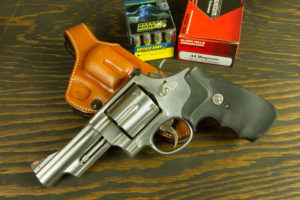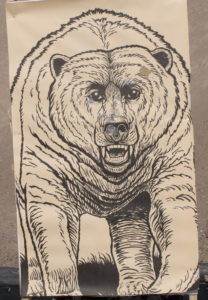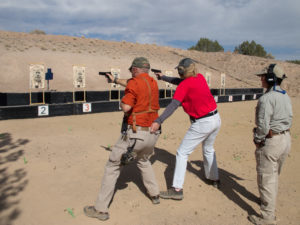Customers often ask firearms retailers to recommend a gun to carry for protection against bears. It's a topic that interests many, even if they never set foot in bear country. Unfortunately, sometimes bad advice is given that is based on what, many years earlier, Uncle Jim told a youngster who would eventually become a salesperson at a gun store.
Bears live in nearly every region of the United States, and all can be dangerous. These tough, hardy animals are not easy to stop when engaged in an attack. While some people may advise using bear spray as a defense, it's probably a good bet that if your gun-store customer is asking for advice on bear protection, a firearm is going to be the choice.
Sure, bear spray has been known to drive away an attacking bear, but it does not work every time it is used. A well-placed bullet from a powerful firearm is much more reliable. But power and accuracy are critical, because a firearm that is not powerful enough, or a bullet that does not hit the right place, is of little protection.
Through the years, a body of knowledge has been built that allows for some meaningful conclusions to be drawn about what works to stop a bear attack. And there is at least one place the average person can go to get the knowledge and training necessary to increase the chance of stopping a bear attack.
Gunsite Academy, located near Prescott, Arizona, has been in operation for more than 40 years. Academy instructors specialize in firearm training for students ranging from honest citizens with no experience to high level, top-tier law enforcement, military and government agency personnel. One of the courses available is Predator Defense.
Gunsite's Predator Defense course lasts five days. Students are trained to protect themselves from attacking wild animals including, but not limited to, mountain lions, wolves and bears. The class is in two parts, one covering protection using a handgun and the other using a long gun such as a rifle or shotgun.
But because one study suggests handguns are used successfully 84 percent of the time to defend against a bear attack and long guns only 76 percent, the emphasis in this article will be on handguns.

The powerful .44 Magnum is considered an effective bear-stopping firearm when used with the right ammuinition. (Photo: Doug Larson)
Why are handguns more successful?
Why are handguns more successful? That's a good question and probably has something to do with the fact that handguns are easier to carry than long guns and can always be with a person, where long guns are often carried on a sling making them hard to deploy or are set down to free the person's hands for some other task. So, where a long gun may not always be at the ready or within reach, a handgun can be.
The course, taught by Il Ling New, a longtime Gunsite instructor and experienced big-game hunter and guide, got its start in 2000. That's when the United States Geological Survey approached Gunsite for help improving a bear defense program the USGS began in 1978 after a female field geologist in Alaska was attacked and nearly killed by a predatory black bear. The USGS apparently came to the conclusion that after 20 years of teaching bear defense, there was a lot more to it than just pointing a gun and shooting a bear. So the agency came to the firearms experts at Gunsite for help.
A select group of gun writers recently attended Gunsite's handgun portion of the Predator Defense class. Since bears are the most robust and hardest-to-stop four-legged predators on the continent, instruction focused on bear protection. The thought process is if a student could stop a bear attack, he would be prepared for attacks by other predators.
Yes, Bears are Dangerous
Misinformation about bear behavior and attacks is everywhere, and some experts will disagree on certain points. But bears are dangerous. While people are advised to take certain precautions when in bear country — like keeping food in tightly closed containers and sleeping in separate tents so if a bear attacks one tent, the person in the other tent may be able to stop the attack — the fact remains that no matter what precautions a person may take, a bear may still attack. While it is reported that about 75 percent of grizzly, or brown bear, attacks are sows protecting cubs, sometimes bears, especially black bears, attack people with the intent of eating them.

Gunsite Academy's intensive training courses for protecting yourself against bear attacks includes large targets, stationary and moving, that give students the opportunity to practice their shooting skills. (Photo: Doug Larson)
Bears are incredibly fast despite their size, so speed of response is essential. Even if a potential victim sees the bear coming, time may be short. In a typical attack, the victim may have as little as .5 to 1.5 seconds to react. Training and practice are essential to survival. But just shooting the bear may not be enough to stop the attack. Bears are tough with heavy muscle and hide and very strong, thick bones. So, the first challenge is for the bullet to penetrate deeply enough to get to vital organs which, when damaged sufficiently, will cause the animal to stop the attack immediately. However, even if the heart or lungs are destroyed, the bear may still have enough oxygen and blood in its system to carry out the attack and kill the victim. Sure, the bear may die, but not before the victim is dead.
The best bet to immediately stop an attacking bear is to turn off its central nervous system, which requires a brain shot or a shot which severs the spinal cord. Since the spinal cord is so small, it makes sense to aim at the brain. But bears have thick, strong skulls shotgun slugs or even rifle bullets may not penetrate. The weakest part of a bear's skull is behind the face, in a small triangular shaped area roughly bounded by the eyes and the tip of the nose. A bullet striking this area has the greatest chance of penetrating the skull, hitting the brain and stopping the attack immediately. But it's a small area, the bear is moving, and the victim is under tremendous stress to respond instinctively before the bear makes contact. To do so requires training and practice under time constraints and pressure. That's what Gunsite provides.
Gunsite teaches the student to draw quickly under stress, aim carefully for the bridge of the bear's nose, and shoot until the charge stops and the threat goes away. It is not like defending against a criminal attack where the defender is taught to shoot to center of mass. Instead, the defender must shoot a smaller target moving much faster than a human. It's a tough problem to solve, so practice is essential.
The student must be very familiar with his firearm, and the gun and ammunition must be up to the task. Most knowledgeable people may agree the minimum caliber handgun suitable for bear protection is a .44 Magnum. The ammunition also is critical, since the bullet must penetrate heavy muscle and bone, and drive into the vital organs.
For the .44 Magnum, the generally recommended load is a hard-cast lead flat nose bullet weighing about 300 grains and driven at about 1,300 feet per second. Buffalo Bore Ammunition offers such a load. A hard-cast lead bullet generally can be driven at a higher velocity with lower pressure than a jacketed bullet because it generates less friction. And a flat nose bullet will penetrate further than a hollow point because it does not expand, which slows a bullet. It also tends to keep moving in a straight line to the vital organs because it crushes its way through bones and tissue instead of being deflected.
For the Gunsite class, I used a Smith & Wesson model 629 chambered in .44 Magnum with a 4-inch barrel. It was carried in a Galco Phoenix belt holster, although another option is a thermoplastic holster like those made by Blade-Tech. Because the class round count was high, Black Hills .44 Special 210-grain lead flat-nose Cowboy Loads were used; they produce less recoil than standard or heavy .44 Magnum loads. For high-round-count training, low-recoiling ammunition saves joints and reduces pain. A Pachmayr Decelerator grip replaced the factory grip. Despite training with light .44 Special loads, a good number of Buffalo Bore heavy .44 Magnum loads were fired for familiarization.

Tandem shooting increases the firepower against a threat while giving the shooters much better awareness of each other's location. (Photo: Doug Larson)
Classes and Range Time
Gunsite training is enjoyable but intense. Gun safety and background on bear behavior was discussed. Then came square-range drills, where fundamentals like drawing and shooting under time constraints were practiced at targets from 3 to 15 yards. We were introduced to charging bear paper targets. The small vital zone around the bridge of the nose was discussed and accuracy was again emphasized. Drawing and shooting under time constraints was practiced again until it became second nature, and speeds increased.
Drills included tandem shooting with two shooters side-by-side moving as a team to increase firepower on a charging bear and have awareness of each other. Another drill included shooting from a stopped ATV, which is more difficult than it looks because the ATV does not offer a stable platform, even when not moving. Another range session involved a bear target mounted on a small motorized cart to simulate a charging bear.
Knowledge of what to do if attacked by a bear is important, but actually practicing the techniques in a training class is what makes the difference between life and death. Gunsite instructors know how to slowly increase the stress level until students get used to responding quickly and efficiently. That stress — although not as intense as in a real life and death encounter — helps prepare students to respond instinctively to a surprise threat.
After repeated practice, we were tested in a training simulator where a bear — actually a bear target on a motorized cart — appeared and charged without warning. Because of the training, quickly drawing and firing was automatic. We were surprised at our newfound ability and realized we were better prepared to deal with a charging predator.
For customers of yours who can attend, the Gunsite Predator Defense course is highly recommended. Retailers should take questions from customers about the best equipment and training for protection against bears seriously and have the right knowledge and hardware to meet the customer's need. Attacks happen every year and concerns about bear attacks are real. Help your customers defend against them successfully.
SPECIFICATIONS
SMITH & WESSON MODEL 629
Caliber: .44 Magnum
Barrel length: 4.125 inches
Overall length: 9.6 inches
Weight: 41.5 ounces
Grips: synthetic
Sights: front red ramp, rear adjustable white outline
Action: double action
Finish: polished stainless
Capacity: 6 rounds
Price: $949
Featured image: Doug Larson






